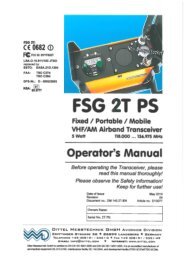AV-1 Manual - MGL Avionics
AV-1 Manual - MGL Avionics
AV-1 Manual - MGL Avionics
You also want an ePaper? Increase the reach of your titles
YUMPU automatically turns print PDFs into web optimized ePapers that Google loves.
<strong>AV</strong>-1 Operating <strong>Manual</strong> Page 10<br />
3D-G<br />
Can provide for accurate heading even during turns as tilt<br />
compensation is based on gyro derived horizon.<br />
accelerometers.<br />
Can show very large errors if the<br />
horizon information is invalid which<br />
could have a number of causes such<br />
as exceeding operational limitations of<br />
the horizon system.<br />
Using the deviation calibration feature<br />
When you install your compass sensor package, it may be surrounded by several items or materials that in some way<br />
change the strength and/or direction of the earth magnetic field that your sensors are measuring. If left unattended, this<br />
may contribute to considerable errors in the heading as indicated by your instrument.<br />
Due to the magnetic sensor not being based on a magnetic item (such as a magnetic needle) as in a normal compass,<br />
the effect of deviation is lessened a little. This is because the needle in a magnetic compass will be attracted by iron, even<br />
if the offending iron has no effect on the magnetic field (i.e. does not change the field direction or strength in a<br />
hypothetical case).<br />
Deviation needs to be corrected if you intend using the compass for navigational purposes. The procedure for this is<br />
traditionally called a “compass swing”. Often, two small magnets are placed close to the compass in an effort to correct<br />
some of the larger errors. Smaller, remaining errors are then noted on a “deviation chart” and this is placed next to the<br />
compass for future reference.<br />
With the SP-1, 2,3 and 6, a very simple method can be used to correct for most of the deviation that may be present in<br />
your aircraft or vehicle. However, before you start, ensure that the sensor package is installed as far away as possible<br />
from any of the following:<br />
• Ferro magnetic materials such as iron, many steels and soft magnetic materials such as ferrites. Any magnets<br />
must be located as far away as possible from the sensor package. This includes electromagnets as used in<br />
solenoids, electrical motors and relays.<br />
• Cables containing large electrical currents. DC currents will cause magnetic fields around the cables which will<br />
lead to deviation. AC currents cause fluctuating magnetic fields that may reduce your compass resolution.<br />
• Be aware that some lower grades of stainless steel may be ferro magnetic.<br />
If in any doubt, use a small magnet to test any metals surrounding the sensor package. We recommend mounting the<br />
sensor package using glued on strips of velcro material. This allows for easy alignment of the sensor package horizontal<br />
to the earth’s magnetic field.<br />
Never perform the deviation compensation procedure or a compass swing if your aircraft is placed on a reinforced<br />
concrete apron or tarmac. The steel that may have been used to reinforce may have a very significant effect on the<br />
strength and direction of the magnetic field at your location.<br />
To start the deviation compensation procedure, enter the menu and select “SET DEVIATION”.<br />
Place your aircraft in flight attitude. For example, if you own a tail dragger, raise the tail.<br />
Some tricycle gear aircraft may need to raise the nose gear slightly. The object is to<br />
place the sensor package as close to horizontal attitude relative to the earth’s surface as<br />
possible.<br />
Proceed as instructed and turn the aircraft through a full 360 degrees at least once.<br />
Allow this procedure to take some time, perhaps a minute. You can proceed to turn your<br />
aircraft though two or more turns, however you need to fully complete at least one full<br />
turn.<br />
If you like, you can press the F1 key during this procedure to see the actual numeric data obtained from the<br />
magnetometers. You will see the instrument tracking minimum and maximum values for each sensor and you can see the<br />
current values.
















